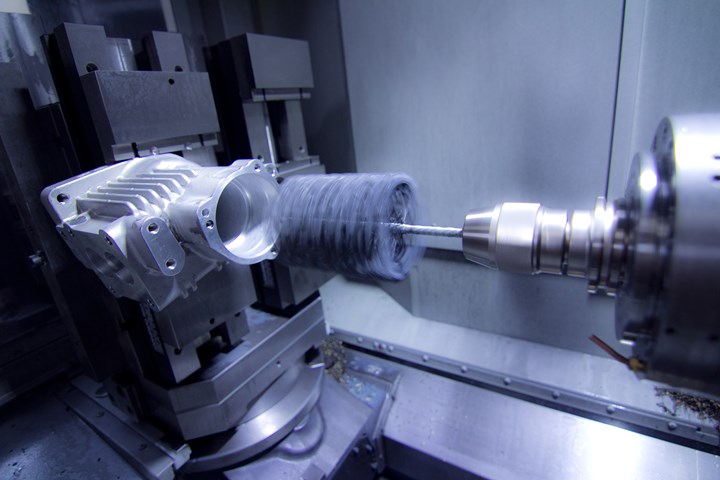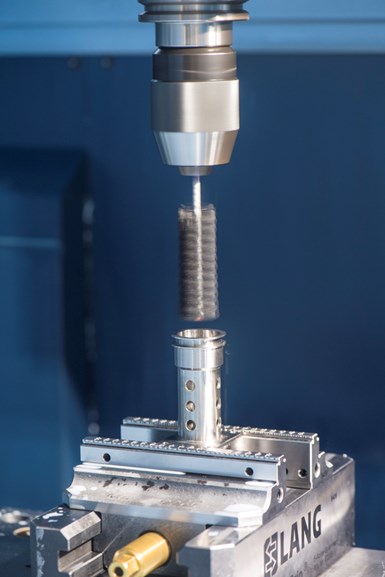
A distinction must be made between abrasives used for aggressive material removal and abrasive finishing tools. Finishing tools release little to no abrasive grit during use.
Photo Credit: All photos courtesy of Brush Research Manufacturing.
In the past decade, Delta Machine Company LLC (Huntington Beach, Calif.), — a machine shop specializing in complex, tight tolerance parts made of titanium, nickel alloys, stainless steel, aluminum, plastics and other exotic alloys — has relied on a flexible honing tool for a wide range of automated CNC machining applications such as cross hole deburring, cylindrical honing, surface finishing, edge-blending and cleaning.
By integrating flexible hones in the machining process, complex parts with cross-drilled holes and other difficult-to-access features can be deburred, honed and surface finished in-house, and therefore at a lower cost.
In automated machining, removal of burrs and sharp edges in cross-drilled holes and other difficult-to-access areas such as undercuts, grooves, slots, or internal holes can be tedious and time-consuming.
Despite the challenges, the removal of burrs from the production process is an absolute must for high-quality, precision parts. In many applications, cross-drilled holes act as conduits for fluids, lubricants and gases. Failing to remove burrs can cause blockage of these critical passages or create turbulence in the flow. Burrs can also lead to part misalignments, affect dimensional tolerances, and limit the overall efficiency of machined components.
“Eliminating burrs is critical because if any loose material gets dislodged during use, there can be serious consequences,” says company president, Janos Garaczi.

Flexible hones are a cost-effective solution to smooth edges and produce a blended radius for cross-hole deburring.
According to Garaczi, the tool he has selected for such applications is the Flex-Hone from Brush Research Manufacturing (BRM, Los Angeles, Calif.). Characterized by the small, abrasive globules that are permanently mounted to flexible filaments, the product is a flexible, low-cost tool utilized for sophisticated cross-hole deburring, honing, surfacing and edge-blending. The hones are available in a variety of abrasive types, sizes and grit selections.
“For deburring holes and honing when we need to clean up a component, it is the easiest tool to use for us. There is a large variety of grades and sizes and it is very versatile,” Garaczi says.
In such applications, flexible hones are ideal because the tools are a cost-effective solution to smooth edges and produce a blended radius for cross-hole deburring.
Garaczi adds, “Right now, we are making more and more complex parts, especially when it comes to housings with ports all over the part. That is where the hone comes in really handy.”
For best results, the deburring tool is typically rotated into the main bore into which the cross holes break. After a few clockwise strokes, the tool is removed and the spindle reversed to rotate and stroke the flexible hone in a counterclockwise direction for a few more strokes. The forward and reverse rotation creates a symmetrical deburring pattern. Coolant should be used to keep metal cuttings and deburred metal in suspension.

A part before and after deburring
According to Garaczi, removing burrs can be particularly problematic when dealing with machined superalloys, such as titanium, Monel, Inconel, Incoloy, Invar, Rene and Hastelloy, which are some of the most difficult materials to machine.
“The burrs are one of the biggest problems, particularly when machining superalloys” Garaczi adds. “Even during ‘grooving,’ if you cut the material from one side, it just pushes the burr to the edge; and if you approach it from the other side, it just pushes it back. It doesn’t want to break off the material cleanly. As soon as the tool gets a bit dull it gets a lot worse. So, sharp tools with the right geometry are key.”
Flex-Hone is available with a premium nickel coated diamond abrasive for use on materials like carbide, ceramic and aerospace steel alloys; as well as a CBN (Cubic Boron Nitride) option that is even harder and is specifically designed for superalloys, which can exhibit high ductility and work hardening that produces a gummy machining behavior if the correct abrasive tool is not utilized.
Garaczi says he is installing the flexible hones into CNC equipment to automate the process and reduce the time required to finish superalloys such as titanium, as well as stainless steels.
Despite the fact that these are abrasive tools, Garaczi says that even though “abrasives” are often all lumped into the same category, a distinction must be made between abrasives used for aggressive material removal and abrasive finishing tools. Finishing tools release little to no abrasive grit during use, and the amount generated is comparable to the metal chips, grinding dust and tool abrasion created during the machining process itself.
Even if minimal fine solids are produced, the filtration requirements for abrasive tools are not much different than for machining. Any particulate can be easily removed using inexpensive bag or cartridge filtration systems.
“When you use the Flex-Hone for deburring, all you are doing is removing the burr. It doesn’t create much dust,” Garaczi adds. “So, for me, any grit or dust released is zero concern.”
He says that when making decisions about what tools to purchase, it is often on a project-by-project basis. However, if the tool can reduce cycle times versus its cost, it is an easy decision.
“There are definitely scenarios where it would be good to be able to perform surface finishing of this type of material on CNCs,” Garaczi says. “It would really save a lot of time and extra processing cost.”
Read Next
Achieving a Mirror Finish
New buffing technology minimizes clean-up and improves quality, cycle time and finish on automatic/robotic applications.
Read MoreHow to Maintain Vibratory Finishing Media
Vibratory finishers and vibratory media require cleaning and maintenance to function properly. Here are tips to keep yours running well.
Read MoreA ‘Clean’ Agenda Offers Unique Presentations in Chicago
The 2024 Parts Cleaning Conference, co-located with the International Manufacturing Technology Show, includes presentations by several speakers who are new to the conference and topics that have not been covered in past editions of this event.
Read More













.jpg;maxWidth=300;quality=90)




